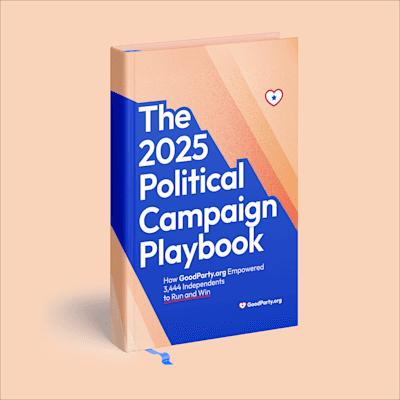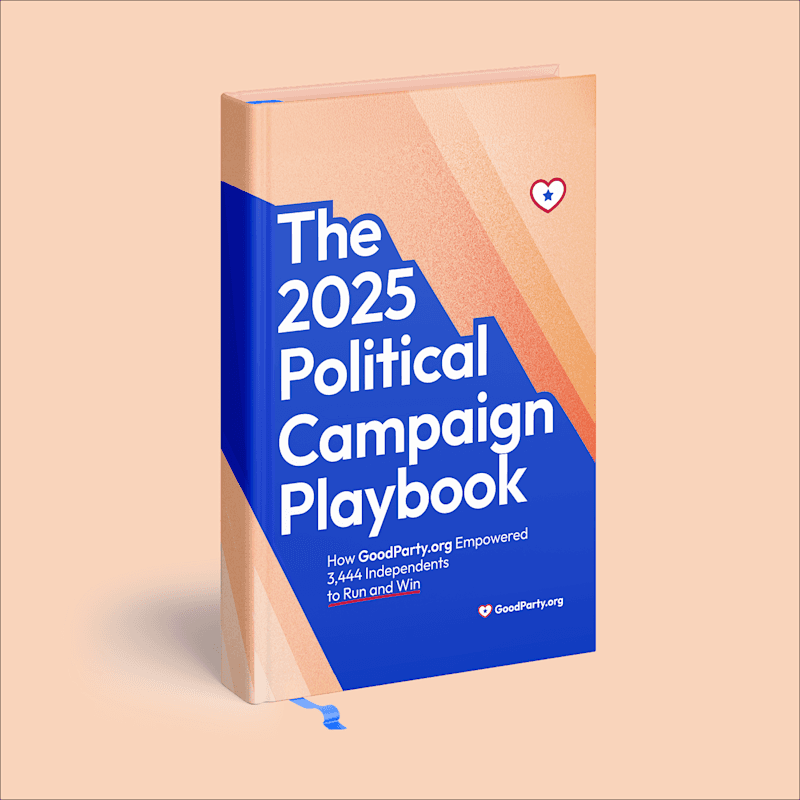
The Ultimate Guide to Political Fundraising in 2025
Political fundraising is how candidates fuel their campaigns, reach voters, and bring their ideas to life. If you’re running a local campaign, starting your first race, or running as an Independent, political fundraising can feel especially daunting. You may not have access to big donors or party infrastructure.
The good news is, you don’t need them. Grassroots political fundraising is not only possible; it’s powerful.
Whether you’re aiming for a school board seat or your city council, this guide is your starting point. We’ll break down what political fundraising is, why it matters, and how to build a plan that works, especially if you’re relying on small-dollar donations.
What Is Political Fundraising?
Political fundraising means asking for and receiving contributions to support your campaign. However, effective fundraising isn’t just about asking for money. It involves building trust, telling your story, and making it easy for people to invest in your vision.
Political fundraising for local and Independent candidates often focuses on:
Individual small-dollar donations from friends, family, and voters
Grassroots contributions through emails and social media
Fundraising events like BBQs or neighborhood meetups
Online platforms that process donations and track donor information
Matching-donation campaigns to double the impact of small donors
Once you’ve got the basics down, the next step is understanding how political fundraising fits into your campaign’s bigger picture.
Why Political Fundraising Matters
Fundraising is about more than just money. Campaign funds give you power, visibility, and the tools to compete. Your supporters may love your mission, but without strategic fundraising, they likely will never hear it.
Political fundraising matters because:
It’s Harder to Win Without It: Running a political campaign costs money. From flyers and yard signs to website hosting and texting tools, political fundraising ensures you have the resources to reach voters. Without funding, your message may get drowned out by better-resourced opponents.
It Builds Credibility and Momentum: Every dollar raised tells the world that people believe in your campaign. A strong political fundraising effort shows voters, the media, and even potential endorsers that your campaign is serious and viable. And when your campaign is powered by small donors, it signals broad community support.
It Expands Your Network: The people who donate to your campaign may also sign up to volunteer, amplify your message, or help recruit others. Building a base of small-dollar donors can grow into a loyal network that fuels your campaign from start to finish.
The more intentional your fundraising efforts, the more effective your overall campaign will be.
How to Build a Political Fundraising Plan
The best political fundraising plans are clear, realistic, and uniquely tailored to you and your campaign. You’ll need to set some goals, determine who you’re trying to reach, make a message that speaks to them, and figure out what tools work best for you.
Step #1: Set Your Goals
Before you start asking people for money, know what you’re aiming for. Your political fundraising goals should match the size and scope of your campaign.
Ask yourself:
How much can I afford on my own?
What’s the total amount I need to run a competitive local race?
What will my biggest expenses be?
How much can I reasonably raise from friends, family, and my community?
Start with a campaign budget. Then, you can break your goal into monthly or milestone targets. This helps you pace your political fundraising and evaluate progress. Every community is different, so you may need to try a few different tactics before you find one that works.
LEARN MORE: Watch our webinar on political fundraising and budgeting.
Step #2: Know Your Audience
Most first-time and local campaigns depend on small donors. But asking your neighbors and community members for money can be tricky. Understanding your community is key.
Ask yourself:
Who already supports me or shares my values?
Who are my neighbors, and what issues matter to them?
Who might give $10, $20, or $50 to help me win?
Go out and start meeting people. Listen to their needs and concerns. You don’t even need funding to start doing that. Town hall meetings, local block parties, and other community events are great opportunities to begin listening to the people around you and figuring out how you can help.
You should expect small donations, typically under $200. Even in massive, presidential campaigns, only a very small percentage of people give large contributions. According to OpenSecrets, only 1.36% of voting-age Americans gave over $200 in political donations in 2024. So, focus on many small donations from across your community instead of looking for big influxes of cash from a few people.
Step #3: Craft Your Message
Your political fundraising message should be short, relevant to your community, and emotionally resonant.
Through your messaging, you need to let potential donors know:
Who you are and why you’re running.
What’s at stake in your local race.
Why a small donation makes a big difference.
Include a clear call-to-action, like "Chip in $10 to help us reach more voters in our community." Links to online donation forms on your website or social media are helpful, too.
LEARN MORE: Get access to free templates for donor outreach emails and fundraising call scripts.
Step #4: Choose Your Tools
You don’t need expensive tools to run a successful political fundraising program. Many Independent and small-town candidates make use of:
Free or low-cost donation platforms
Email and SMS tools with grassroots reach
Spreadsheets or simple CRMs to track donors
Focus on finding tools that are easy to use for you, your team, and your donors. It should really take your supporters less than two minutes to donate. Any longer, and they may lose steam.
ActBlue found that in 2024 nearly 70% of donations came from mobile devices. So, finding mobile-friendly tools is also crucial in our digital age.
Lastly, look into integrations. If you’re already using other political campaign management software, finding a tool that works seamlessly with it can help save you and your team time and frustration.
LEARN MORE: Maximize your campaign with online fundraising platforms.
4 Smart Strategies for Political Fundraising Success
Fundraising doesn’t have to feel overwhelming. These tried and true strategies are designed to help first-time and local candidates raise money in ways that feel doable and authentic.
#1: Use Social Media to Reach Small Donors
Social media is one of the most effective, powerful, and free tools for local political fundraising. On your socials, you can:
Share your personal story and local values
Highlight campaign milestones
Ask for small-dollar donations with simple links
Host fundraising challenges or countdowns
LEARN MORE: Not sure where to start? See how to create content to generate fundraising.
#2: Host Low-Cost Fundraising Events
Your fundraising events don’t have to be fancy. They should feel genuine to your campaign messaging. Some easy and cheap ways to raise money and build relationships include:
Coffee chats at local cafes
Neighborhood potlucks or fundraising dinners
Online meet-and-greets with a $5–$10 suggested donation
Don’t forget to grab the contact info of attendees to follow up!
LEARN MORE: Get inspired with these unique fundraising ideas.
#3: Tap Into Your Personal Network
Friends, family, coworkers, and community members are often your first and best donors. Ask them personally to contribute and share your campaign with others. Even $5 donations can add up when your network is activated.
#4: Make It Easy to Give
Keep your fundraising process simple:
Use a short, memorable donation link
Offer preset donation buttons ($10, $25, $50)
Explain exactly how their donation will help ("Your $15 helps print 100 flyers.")
Consider adding short testimonials or impact statements to your website and outreach efforts. Small personal touches help build trust and reinforce the value of each contribution.
Remember to follow up. Thank every donor quickly, either through an automated email, a personal text, or a quick social media shout-out. Appreciation goes a long way, and consistent stewardship encourages repeat giving.
#5: Track Your Progress to Improve Over Time
Political fundraising is an ongoing process. Throughout your campaign, regularly review:
How much you’ve raised vs. your goals
Which messages resonate most with small donors
Where you can improve outreach or follow-ups
Try different things to see what works. Then, use the data you collect to refine your strategies. If it’s your first campaign, it’ll be difficult, but remember that you can use these learnings in future races and reelection efforts.
LEARN MORE: Power your campaign to victory by following our best practices for political fundraising.
Legal Considerations: Political Fundraising the Right Way
Political fundraising is highly regulated at the local, state, and federal levels. As a first-time or Independent candidate, you need to ensure you know the laws so you can avoid any negative repercussions.
Some important things to look into before you start fundraising include:
Learn your area’s contribution limits. Your state may have different regulations than your town or county, too.
File any necessary campaign finance forms early. If you miss a deadline, you may be disqualified from your race.
Track every donation — even small ones.
Check with your local election board or secretary of state to ensure compliance. If possible, recruit a trusted volunteer to help manage finances or consider hiring a campaign treasurer to keep everything above board.
LEARN MORE: See how to open a campaign bank account to keep your funds straight.
Grassroots Fundraising Can Power Your Win
Political fundraising is about showing voters that you’re serious, community-backed, and ready to lead.
You don’t need big money or political connections to run a strong campaign. If you’re committed, clear about your message, and willing to ask for support, you can build a movement powered by your neighbors and supporters.
GoodParty.org is here to support you every step of the way, from building your campaign website to writing donation emails to tracking your progress. Let’s fund your movement, together.
Photo by Annie Spratt on Unsplash
Book a demo today to learn how GoodParty.org can empower you to win.

